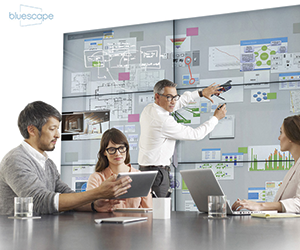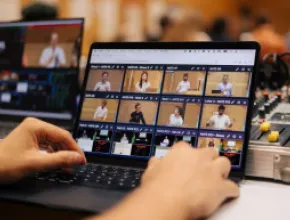There’s nothing worse than spending money on a new piece of technology that doesn’t work.
Whether it’s because your attendees don’t know how to use it—or more likely there isn’t enough bandwidth available to support it—flashy tech is often set aside for the devices we are most familiar with, such as our own tablets and mobile phones. But even those devices can fail us when we need them most, such as navigating the show floor during a big event.
“All of this great technology that people talk about is predicated on having a live Internet connection and the proper bandwidth, and in 95 percent of venues that doesn’t exist today,” says Chris Kelly, co-founder and principal of Convene, a New York City-based conference center group.
The time has come when planners need to discuss their group’s technological needs well in advance of their meetings, and also during contract negotiations right alongside food and beverage, or room rates and attrition.
Meetings Focus spoke with industry tech veterans and some up-and-coming innovators who are looking to change the way we think about meetings technology, highlighting the importance of bandwidth as well as some new tools and trends in the industry. PageBreak
Bolstered by Bandwidth
Every expert we interviewed mentioned one specific thing that stood in the way of utilizing technology during an event—the amount of bandwidth available, i.e., the speed at which data can be transferred without interruption whether it’s a shared (weaker) or dedicated (stronger) connection.
“The most important conversation right now in tech is also the simplest conversation,” says Jim Spellos, meetings tech speaker and president of Meeting U. “Hotels and planners still don’t fully get the bandwidth discussion yet. It’s not being addressed at the point of negotiation, but it’s really going to be the core competency in determining whether a hotel or venue is successful.”
Spellos says much of this conversation comes down to a site’s infrastructure, which generally hasn’t been able to keep up with the attendee’s thirst for mobile and tablet devices, let alone the “wow factor” tech you hear about in the news, such as wearable devices and anything 3D. He cited the Mandarin Oriental Hotel Group’s recent move toward fiber-based interconnectivity (as opposed to copper-based) as thinking with an eye to the future.
“I don’t think you can plan an infrastructure for 10 years out that will be adequate for our tech needs when it gets to that time,” Spellos says. “It really makes the decisions difficult for hotel GMs, for hotel executives, as well as for planners, especially for larger groups which are planning three, five or even seven years down the road; you almost would have to do a site selection again 12 to 16 months out and see where things stand.”
Perhaps the most well-known proponent of the fiber-optic network is Google, which is working toward deploying its Internet service (claimed to be 100 times faster than the average broadband connection) in Kansas City, Mo., Provo, Utah, and Austin, Texas. Spellos noted Google Fiber is expected to be in place for the 2014 South by Southwest (SXSW) event in Austin, and that he’s interested in seeing how it performs.
“Fiber could be one of those solutions for conference centers and hotels down the road, yet it’s going to be an expensive one,” Spellos says. “Think of how much it’s going to cost to rewire a property.” PageBreak
A Model for the Future?
Christopher Kelly and Ryan Simonetti were two young entrepreneurs with a mission to redefine how suppliers approach meetings when they founded Convene in 2009.
“The hope is that a meeting will have a resounding impact on the larger success of the company or organization that’s hosting it,” Kelly says. “We thought the tremendous strategic importance of meetings was not really well matched with a product, space and service that really took that into consideration. We often found that hotels treat meetings like a wedding with a projector.”
Convene was recently named by Crain’s New York Business as the fastest growing company in New York City. The company develops and operates full-service conference centers and collaboration spaces while working under a 100 percent vertically integrated service model with its own culinary, planning and operations departments.
“Convene is different from most other conference centers in that we build out and design all of our own spaces with a local focus,” Kelly says. “So our Times Square property is built with the understanding there’s going to be a heavy usage of media-type companies in that neighborhood, whereas our downtown financial district location anticipates a lot of financial users.”
The continual testing of equipment with the proper bandwidth and routers is vital to maintaining an error-free environment. According to Kelly, Convene operates on a 12-point basis in which every piece of hardware within its walls receives a monthly checkup–one hard checkup and one soft checkup—of its condition and performance. The goal is to create a flawless technological experience for meetings so there aren’t any hiccups when streaming a hybrid event or just trying to load up a video or presentation.
“We believe the most important technology that conference participants rely on for productivity–and not the wow factor–are the cell phones and laptops that they walk through the door with,” Kelly says. “And if you can provide a meeting environment that allows them to use those devices successfully, they’re going to be more productive.”
Convene hosts everything from conversations between two people to events for groups of up to 400. The challenge larger convention centers face is dealing with a lot more people using multiple devices, but it is possible they could use the company’s IT-first approach for inspiration. PageBreak
Cutting-Edge Tech
Once an adequate level of bandwidth is achieved, planners can finally start implementing some of the more-exciting event technology on the market.
“I’m very interested in what GenieConnect and Active Events are doing to deal with big data and business intelligence surrounding an event,” says Corbin Ball, a veteran events technology speaker and consultant.
GenieConnect and Active Network have both been moving toward providing an all-in-one platform combining registration, event app and strategic meetings management services that can be integrated across all devices. Active Network just announced the launch of its Smart Events cloud this October to help event planners at mid- to-large-size companies better track the value of their meetings.
“Especially for smaller or mid-sized conferences, utilizing tablets with registration-based tools to allow for easy check-in, scanning of information, and anything else to simplify the process will continue to be popular,” Spellos says.
Spellos says he believes many planners will find value in traditional three-ring binder replacement apps (such as GetPlanning), which serve as a digital method to organize notes and information.
“If we are going to talk what’s hot, next year is going to be the year of wearable technology, from Google Glass to the Samsung smartwatch and beyond,” Spellos says. “But we’re probably 10 years away from those becoming even a partial conference component.”
Kelly of Convene mentioned he was most excited about a product named Bluescape by office-furniture maker Haworth and Obscura Digital, based in San Francisco. Bluescape offers scalable multi-touch displays that he says compare to an “oversized iPad, or even an iPad wall.”
“Large touchscreens that make information visible and shareable to a group are really great meeting room resources,” Kelly says.
He said Convene plans to be one of the first conference centers to use Bluescape’s technology and that he expects other convention centers to start incorporating larger touchscreen displays as well.
Midori Connolly, Chief AVGirl at AVGirl Productions, predicts the Bring Your Own Device (BYOD) movement will continue to overtake the speaking circuit, in which sessions are enhanced by using attendees’ own mobile devices to drive their participation.
“I’m excited about finding more ways to make an individual feel connected to the larger picture in the room and having control over their own experience,” Connolly says.







